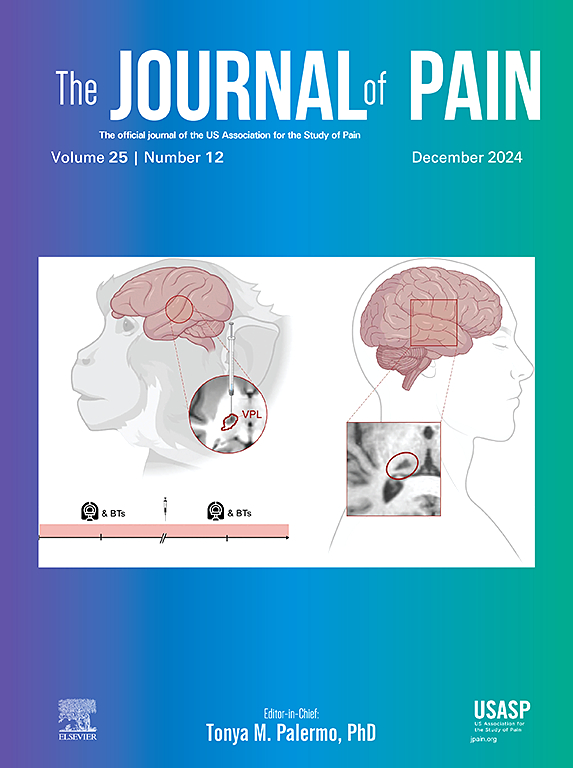The Role of Pain and Interpretation Bias in Fear of Disease Progression in People With Diabetes
IF 4
2区 医学
Q1 CLINICAL NEUROLOGY
引用次数: 0
Abstract
Research indicates that fear of progression (FoP) may be a transdiagnostic construct underlying anxiety in people with chronic health conditions. Theories propose that the interpretation of illness-related symptoms (such as pain) might be an important mechanism driving the development of FoP. However, FoP has rarely been studied in diabetes. In this study, we assessed FoP, pain, health threat-related interpretation bias, emotional states, and treatment adherence in 198 participants with type 1 or type 2 diabetes and an age- and gender-matched control group. We hypothesized that 1) people with diabetes will be more likely to interpret ambiguous stimuli as health threat-related than people without diabetes; 2) among those with diabetes, pain severity and interpretation bias will be associated with more severe levels of FoP; and 3) interpretation bias will moderate the relationship between pain severity and FoP in people with diabetes, such that the positive association between pain and FoP will become stronger when people have greater interpretation bias. Our results confirmed that people with diabetes were more likely to interpret ambiguous information as health threat-related compared with people without diabetes, with a large effect (d = .84). Moreover, people with diabetes who reported persistent pain were more likely to interpret ambiguous stimuli as health threat-related (d = .49). Among people with diabetes, pain severity and interpretation bias were significantly associated with FoP. However, we did not find evidence that interpretation bias moderated the relationship between pain and FoP and these relationships could not be accounted for by general psychopathology.
Perspective
People with diabetes had greater health threat-related interpretation bias than people without diabetes, especially for those with persistent pain and more severe FoP. Both pain severity and interpretation bias were associated with greater FoP, but interpretation bias did not moderate the relationship between pain and FoP.
疼痛和解释偏差在糖尿病患者对疾病恶化的恐惧中所起的作用。
研究表明,对疾病进展的恐惧(FoP)可能是慢性病患者焦虑的一种跨诊断结构。有理论认为,对疾病相关症状(如疼痛)的解释可能是导致 FoP 发生的重要机制。然而,人们很少对糖尿病患者的焦虑进行研究。在本研究中,我们评估了 198 名 1 型或 2 型糖尿病患者以及年龄和性别匹配的对照组的 FoP、疼痛、健康威胁相关解释偏差、情绪状态和治疗依从性。我们的假设是:1)与非糖尿病患者相比,糖尿病患者更有可能将模棱两可的刺激解释为与健康威胁相关;2)在糖尿病患者中,疼痛严重程度和解释偏差将与更严重的FoP水平相关;3)解释偏差将缓和糖尿病患者疼痛严重程度与FoP之间的关系,因此,当解释偏差较大时,疼痛与FoP之间的正相关将变得更强。我们的研究结果证实,与非糖尿病患者相比,糖尿病患者更有可能将模棱两可的信息解释为与健康威胁有关,且影响较大(d=0.84)。此外,报告持续疼痛的糖尿病患者更有可能将模糊刺激解释为与健康威胁有关(d=0.49)。在糖尿病患者中,疼痛严重程度和解释偏差与 FoP 显著相关。但是,我们没有发现证据表明解释偏差调节了疼痛与FoP之间的关系,而且这些关系无法用一般心理病理学来解释。视角:与非糖尿病患者相比,糖尿病患者的健康威胁相关解释偏差更大,尤其是那些有持续性疼痛和更严重的病情发展恐惧(FoP)的患者。疼痛严重程度和解释偏差都与更严重的病情恶化恐惧有关,但解释偏差并不能调节疼痛和病情恶化恐惧之间的关系。
本文章由计算机程序翻译,如有差异,请以英文原文为准。
求助全文
约1分钟内获得全文
求助全文
来源期刊

Journal of Pain
医学-临床神经学
CiteScore
6.30
自引率
7.50%
发文量
441
审稿时长
42 days
期刊介绍:
The Journal of Pain publishes original articles related to all aspects of pain, including clinical and basic research, patient care, education, and health policy. Articles selected for publication in the Journal are most commonly reports of original clinical research or reports of original basic research. In addition, invited critical reviews, including meta analyses of drugs for pain management, invited commentaries on reviews, and exceptional case studies are published in the Journal. The mission of the Journal is to improve the care of patients in pain by providing a forum for clinical researchers, basic scientists, clinicians, and other health professionals to publish original research.
 求助内容:
求助内容: 应助结果提醒方式:
应助结果提醒方式:


